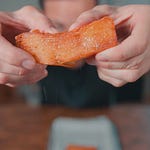Long ago, in the fertile valleys of China, the peach tree first blossomed. Revered for its beauty and sweetness, the peach quickly became a symbol of longevity and immortality in ancient Chinese culture. Poets and artists celebrated its delicate blossoms and luscious fruit, and it was often featured in the gardens of emperors and nobles.
The peach's journey from the East to the West began in the early centuries AD, carried along the ancient Silk Road by traders and explorers. The fruit’s reputation for flavor and beauty made it a sought-after commodity. By the time it reached Persia, the peach had already garnered a legendary status. The Persians called it "Persian apple," and from there, it made its way to the Mediterranean region, including Greece and Rome.
In the warm climates of southern Europe, the peach thrived. Roman farmers meticulously cultivated the fruit, improving its varieties and spreading it across their vast empire. By the early Middle Ages, peaches were a familiar sight in the orchards of Spain and Italy. The fruit's allure continued to grow, eventually reaching northern Europe, where it was cultivated in monastery gardens.
The Age of Exploration in the 15th and 16th centuries marked the peach’s next great journey. Spanish explorers brought peach seeds to the New World, planting them in the fertile soils of Florida and the Caribbean. The fruit adapted well to its new environment, and before long, peaches were being cultivated throughout the southern colonies of what would become the United States.
In colonial America, the peach was a symbol of prosperity and abundance. Settlers appreciated its versatility, enjoying it fresh, dried, or preserved. Thomas Jefferson, a noted horticulturist, grew several varieties at his Monticello estate, helping to popularize the fruit further.
As America expanded westward, so did the cultivation of peaches. The Gold Rush brought settlers to California, where the state's warm, dry climate proved ideal for growing peaches. By the late 19th century, California had become a major producer of the fruit. Meanwhile, in the South, particularly in Georgia, peaches became a significant agricultural product, earning Georgia the nickname "The Peach State."
The peach is a beloved fruit around the world. Its journey from ancient China to modern-day kitchens is a story of exploration, cultivation, and innovation. The peach's rich history is a testament to the human desire for sweetness and beauty, and its enduring popularity ensures that it will continue to be a cherished fruit for generations to come. Go to the market and find the most beautiful one you can
Here is my twist on a classic summer salad:
Frozen peach, pistachio pesto and Buratta
Serves 4
2 frozen peaches
2-4 balls of burrata
Pistachio Pesto (below)
Pistachio Pesto
1 garlic clove
1/2 tsp coarse kosher salt
3 cups freshly picked basil
3 tablespoons raw pistachios
Heaping 1/3 cup grated cheese, a mix of parmigiano reggiano and pecorino 4T Parm, 1.5 T pecorino (a little more is ok)
Use a mortar to crush garlic and salt into a paste.
Add the basil, and move the pestle in a circular motion around the inner rim of the mortar to
crush, rather than pounding it in an up-and-down motion.
Add the pine nuts, and combine into the garlic and basil in the same way. Repeat with the cheese until you have a thick, bright paste.
With a spoon-not the pestle-stir in olive oll.
Split the balls of Buratta open into a bowl or plate, spoon the sauce over the cheese and shave the frozen peaches over the top













Share this post